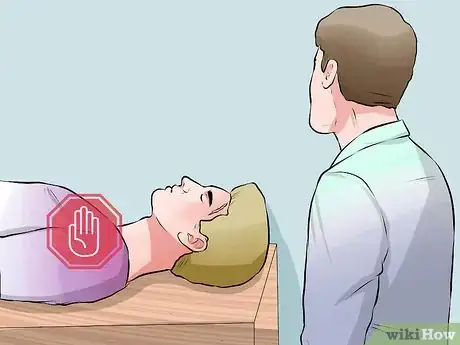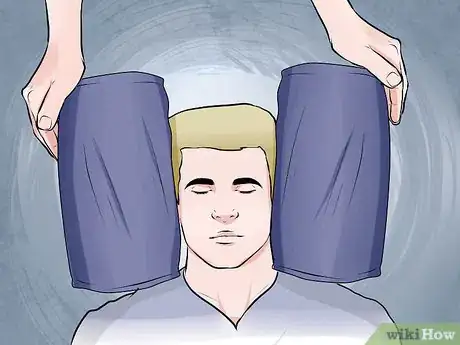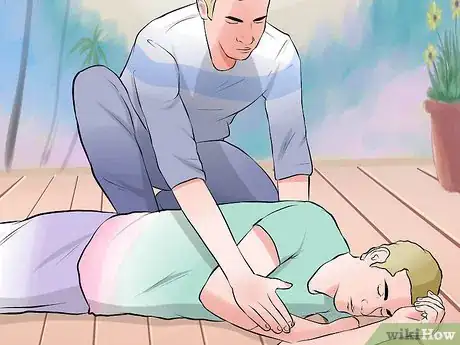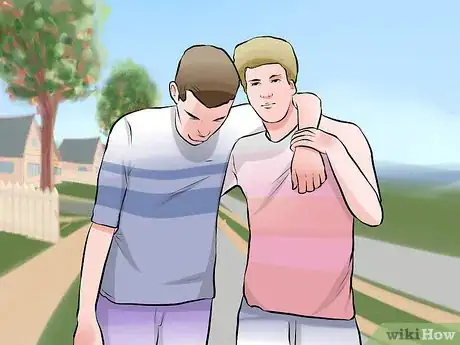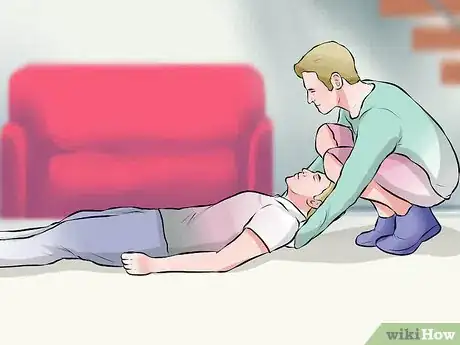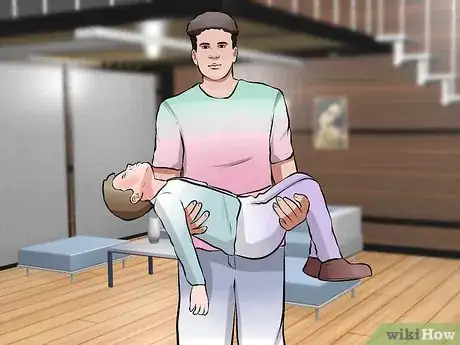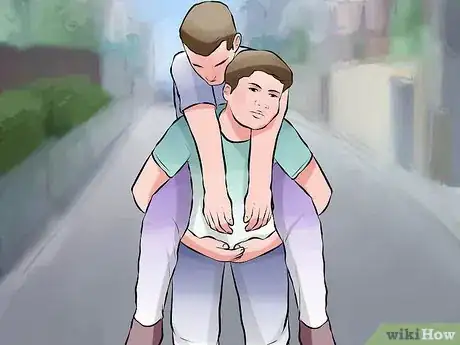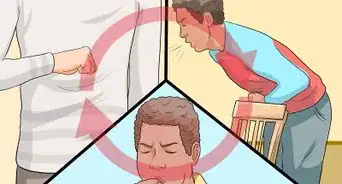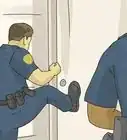This article was medically reviewed by Luba Lee, FNP-BC, MS. Luba Lee, FNP-BC is a Board-Certified Family Nurse Practitioner (FNP) and educator in Tennessee with over a decade of clinical experience. Luba has certifications in Pediatric Advanced Life Support (PALS), Emergency Medicine, Advanced Cardiac Life Support (ACLS), Team Building, and Critical Care Nursing. She received her Master of Science in Nursing (MSN) from the University of Tennessee in 2006.
wikiHow marks an article as reader-approved once it receives enough positive feedback. In this case, 84% of readers who voted found the article helpful, earning it our reader-approved status.
This article has been viewed 290,296 times.
Do not move an injured person unless they are in a life-threatening situation. Moving an injured person can worsen the injury. If the person has a spinal injury it can cause them to be permanently paralyzed. If the person is not in immediate, life-threatening danger, call emergency responders for medical help. If you do need to move the person out of life-threatening danger, it is important to do it correctly to reduce the risk to the injured person and to yourself.[1] [2]
Steps
Protecting the Spine
-
1Do not move someone if you think she has a spinal injury. Moving them could increase the damage and even cause them to be paralyzed. If you are unsure if the person has a spinal injury, then you should proceed as if they do. Signs of a spinal injury include:[3] [4]
- Having a head injury, particularly one that involved a blow to the head or neck.
- Showing changes in the state of consciousness, for example, being unconscious or confused.
- Experiencing pain in the neck or back.
- Not moving the neck.
- Experiencing weakness, numbness, or paralysis in the limbs.
- Losing control of the bladder or bowels.
- The head or neck is twisted in a strange position.
- Reacts to painful stimulus (trapezius pinch or sternal rub) by flexing all their limbs inward or by extending all her limbs out (referred to as posturing).
-
2Stabilize someone with a spinal injury. If the person’s head or body moves, it may increase the damage to the spine. You can prevent this by:[5]
- Putting towels or pillows on both sides of the person’s head to prevent it from rolling or slipping.
- Providing first aid, like CPR, without moving the head. This means that you should not tilt the person’s head back to open the airway. Instead, use the jaw-thrust method.
- Not taking the person’s helmet off if he was wearing one. For example, if they had a bike or motorcycle helmet on, leave it so you don’t move the spine.
Advertisement -
3Roll the person onto their side if necessary. This should only be done if the person is in immediate danger, for example, if they are vomiting or choking on blood. Under these circumstances, you may have to roll the person onto their side. It is important to do this with at least one other person so that you can prevent the person’s body from twisting.[6]
- One person should be positioned at the head and the other at the injured person’s side. The two of you must coordinate so that the spine remains aligned while the person is rolled. Twisting can cause additional damage to the spine.
- While rolling, wait for the lead person's cue. Roll by grabbing the opposite shoulder and hip, rolling the patient toward you. While the person is in this position, check their back and neck quickly for obvious injuries.
Moving a Person Without a Spinal Injury
-
1Use the human crutch method. If the person is conscious and can move on their own, this method might be the most effective. It can be used if the person has an injury to only one leg.[7]
- Crouch with your knees bent and back straight next to the injured person on the side of the injury. Have the person sit up and wrap their arm over your shoulder. Slowly stand, allowing the injured person to support themself with their good leg. You will support their weight on the side with the injury. Hold their hand around your shoulders with the hand furthest from them. Put your other hand around their waist.
- Help them balance as they hop to safety. This enables them to minimize the amount of weight that must go on the injured leg.
-
2Drag the person to safety. The drag method is safer than lifting the person, for both you and the injured person. Lifting increases the amount of weight that you must support and it puts the person at risk of falling. Always pull slowly and steadily, moving the person in as straight a line as possible. You want to keep the person’s spine aligned so that it does not twist or bend unnaturally. Which type of drag you use will depend on the injures that the person has.[8]
- Blanket pull — This is the most preferred way to drag someone who’s been injured. Move the person onto a large blanket using a “logroll” or three-person lift. Keep the person’s head about 2 feet (0.61 m) from the corner of the blanket. Wrap the blanket around the person and try to pull them in as straight of a line as possible. Keep your back straight and use your legs to pull the person.[9]
- Shoulder pull — This method is necessary when the person has leg injuries and is the best method to support the person’s head. Bend forward at the waist and keep your knees bent. Hold onto the injured person underneath their shoulders right behind their armpits. Support the person’s head as you pull them.[10]
- Ankle pull —This method is used when the person has no leg injuries, but cannot walk. Bend at your knees so that your back remains straight, but you can hold the person’s ankles. Lean back and slowly and steadily use your weight to drag the person to safety. Be careful not to drag the person over surfaces or objects that may injure them. If you are sure that the person has not suffered a spinal injury, you can lift the head and put something underneath to protect it. If you think the person might have a spinal injury, you should move the head as little as possible.[11]
- Clothing drag — If the person has injuries on both the arms and legs, it may be necessary to drag them by their clothing. If you use this method, pay attention to the clothing to make sure that it doesn’t suddenly tear and cause the person’s head to bang on the ground. Bend your knees and grip the clothing under the armpits. Lean back and use your weight to drag the person.
-
3Carry a child using the cradle method. This method is quick and easy but it can only be used for children and people who are much smaller than the rescuer. Because the person’s entire weight hangs on your arms, you will tire quickly.[12]
- Scoop the child up so that you are carrying them in front of you with one hand around their back and the other under his knees.
- Bend at the knees and keep your back straight when lifting. If you injure your back in the process of lifting the person, you won’t be able to help as effectively.
-
4Carry a larger person like a backpack. This method can be used if the person is too large for you to carry in the cradle position or the person must be carried too far for you to maintain the cradle position. It can be used for people who are unconscious.[13]
- Start with the injured person on their back. Bend their legs and stand with your feet on their toes. Pull them up by their wrists to a standing position.
- As you put the person into a standing position, rotate so that the person’s chest is against your back and their arms are over your shoulders. This allows you to hold the person’s arms, tip forward slightly at the waist, and carry the person like a backpack.
References
- ↑ http://www.mayoclinic.org/first-aid/first-aid-spinal-injury/basics/art-20056677
- ↑ http://www.stjohn.org.nz/First-Aid/First-Aid-Library/Immediate-First-Aid1/Emergency-Procedures/
- ↑ http://www.mayoclinic.org/first-aid/first-aid-spinal-injury/basics/art-20056677
- ↑ http://www.nhs.uk/Conditions/Accidents-and-first-aid/Pages/The-recovery-position.aspx
- ↑ http://www.mayoclinic.org/first-aid/first-aid-spinal-injury/basics/art-20056677
- ↑ http://www.mayoclinic.org/first-aid/first-aid-spinal-injury/basics/art-20056677
- ↑ http://firstaidtrainingclasses.ca/first-aid-training-classes-carrying-injured-victims-alone/
- ↑ http://www.stjohn.org.nz/First-Aid/First-Aid-Library/Immediate-First-Aid1/Emergency-Procedures/
- ↑ https://www.cert-la.com/cert-training-education/lifts-carries/
- ↑ https://www.cert-la.com/cert-training-education/lifts-carries/
- ↑ https://www.cert-la.com/cert-training-education/lifts-carries/
- ↑ http://firstaidtrainingclasses.ca/first-aid-training-classes-carrying-injured-victims-alone/
- ↑ http://firstaidtrainingclasses.ca/first-aid-training-classes-carrying-injured-victims-alone/
About This Article
Before carrying an injured person by yourself during first aid, make sure they don't have a spinal injury, since moving them could cause paralysis. If the person does appear to have a spinal injury, put towels or pillows on both sides of their head to keep it as still as possible. Otherwise, if the injured person is conscious and is able to move, crouch next to them, have them sit up, and wrap their arms over your shoulder and around your waist. Then, slowly stand and walk them to a safe spot. Alternatively, drag the person to safety by their legs or arms, depending on where they’re injured. For more tips from our Medical co-author, including how to safely carry a larger person during first aid, keep reading!
